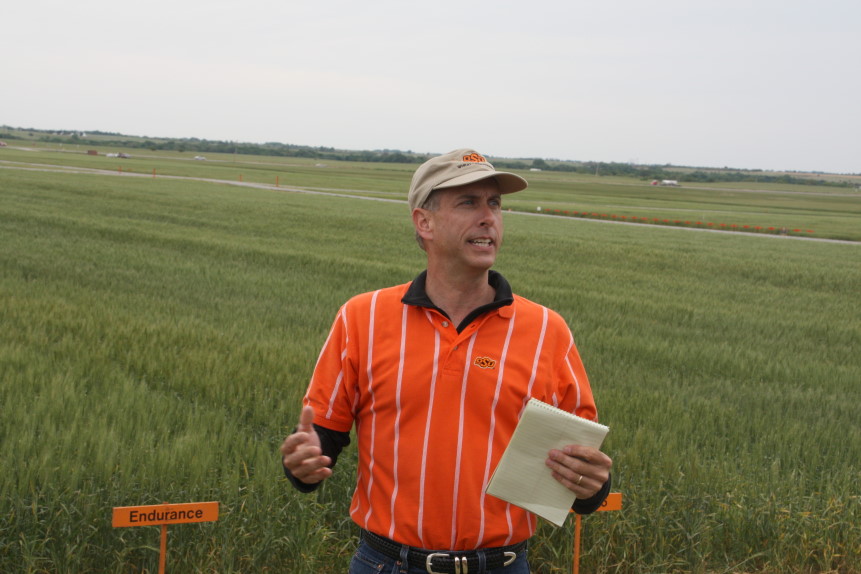
Agricultural News
OSU Researcher Tackles 'Glutenoia'
Mon, 05 Mar 2012 14:50:59 CST

Gluten, which is the protein found in wheat, rye and barley, has gotten a bad rap of late. Celebrities from Oprah Winfrey, to Gwyneth Paltrow, Rachel Weisz and Victoria Beckham have all been linked to a gluten-free lifestyle which is touted as being the miracle cure from to everything from thick thighs to ADHD.
But there are many voices in the scientific and agricultural communities that are saying, "Not so fast."
Dr. Alessio Fasano, the medical director of the University of Maryland Center for Celiac Research in Baltimore, Maryland, says a gluten-free diet does indeed help a genuine health problem, celiac disease. He says a little less than one percent of Americans suffer from this problem, however. Other Americans, maybe six to seven percent, may have a sensitivity to gluten which may cause a variety of gastric symptoms.
Despite these facts, a large number of Americans have come to believe that wheat gluten is somehow bad or dangerous. Dr. Brett Carver of Oklahoma State University has come to call this misperception "glutenoia."
"Right now there seems to be this fad or trend that the human population thinks that gluten is harmful to us. There is some truth to that, but I think this is the classic case where the truth has become stretched a little bit and now we cannot tell the difference between fact and fantasy," Carver says.
He cites Fasano's work on celiac disease which, to the less than one percent of Americans who do suffer from it, is a very debilitating and dangerous disease aggravated by wheat gluten. An auto immune response in celiac suffers actually destroys the vilii in the small intestine and can lead to malnutrition and cancer.
"These people cannot consume gluten," Carver says, "and, therefore, cannot consume wheat in its present state."
When added to the six or seven percent who suffer from some other discomfort related to gluten and who try to avoid foods containing gluten, Carver says, "the problem is that seven or eight percent of our population has become inflamed where almost half of our population thinks the consumption of wheat is bad for us. Part of that's coming from, again, misinformation by sources we think are credible in the medical profession, for one.
Without any scientific evidence to back up their claims, Carver says, these sources are saying that the way wheat has been bred and produced over the last 50 years has produced a different kind of grain than our grandfathers produced. These sources are then laying the cause of the obesity and diabetes epidemics at the feet of current wheat producers.
"What a terrible stretch of fact," Carver says. And, he says, stretching the facts ultimately makes it very difficult on consumers.
"You will have medical doctors on the other side say there are certain types of wheat foods like whole wheat pasta, whole wheat cereals, a lot of whole wheat foods are very important to our diets. We know that as fact but then we have other people who say, 'Well, wheat gluten is just not the same as what it was, so we need to stop eating it.'"
As a scientist and the head of OSU's wheat improvement team, Carver says we should all be concerned with the truth.
Is today's wheat different from that which first debuted in Turkey and Russia and made its way to America?
"Sure," Carver says. "It looks a little different and that's what's being misinterpreted, too. You know we've got a shorter plant than we did 50 years ago, and that's a good thing because now we can better utilize fertilizer, the most expensive input we have, or one of the most expensive. Semi-dwarf wheat allows us to use those inputs more effectively.
"But those who don't understand that will look at the difference in the plants and say, 'Oh, well, you're producing a "Frankengrain" that's two feet shorter than what it was. It must be different. It must not be good for us.'"
While externals have changed through breeding programs, Carver says the grain itself shows very little change.
"It's really not that different. The protein composition, we know the protein amount hasn't changed in 15 years. There are those who think that the protein content has been increased with breeding. No it has not."
To those who say the protein itself must have changed in some way, Carver says there isn't sufficient evidence to draw that conclusion, but more testing would be helpful in that area.
It's those gaps in data that he says help to fuel "glutenoia."
"Not having that kind of concrete information, I think, provides a fertile ground for those who want to stretch misinformation and put stuff out there that instills a lot of fear. It sells books."
So what's the proper response of the wheat industry?
"I could do a lot of talking," Carver says, "but it's going to take more than me as a wheat breeder, me as a scientist to speak this message. It takes, I think, the medical profession to straighten this out. I think it's going to take very well-informed dieticians to help straighten this message out about wheat and wheat gluten. It will take those who are not even immediately connected to the wheat industry, but who know how to separate fact from fiction to get this message out."
You can hear the full interview with Dr. Brent Carver by clicking on the LISTEN BAR below.
WebReadyTM Powered by WireReady® NSI
Top Agricultural News
More Headlines...




















